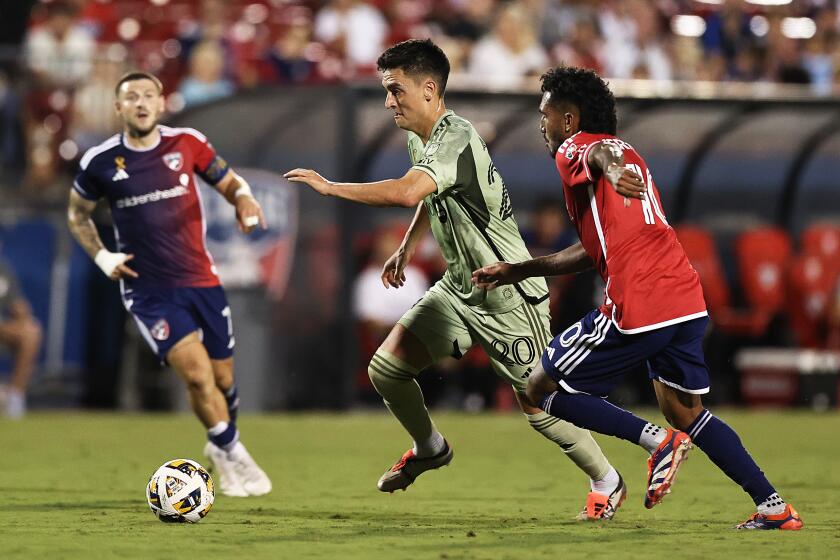Zone Defense Impresses U.S.
It was an almost surreal scene. Believable because it was right there in plain view, but at the same time mirage-like as it shimmered in the mid-morning haze. There but not there.
Picture it now:
In the foreground, U.S. World Cup soccer players and coaches in dark blue warmups mingle and joke with American and South Korean soldiers in camouflage fatigues as they pose together for a photograph.
In the middle ground--literally, since this is the DMZ, the demilitarized zone that divides the Korean peninsula--small groups of infantrymen stare each other down across a not-so-imaginary line drawn in the sand.
In the background, on the far side of the line, another group poses for a photograph, this one composed of Chinese tourists, the women holding pastel sunshades of pink and blue and yellow and green.
This, American visitors are told, is what President Clinton once called “the most dangerous place on Earth.” The air of menace is real even if the entire scene is surreal.
American soldiers speak of being taunted on an almost daily basis, of North Korean soldiers making throat-slitting gestures toward them. Sometimes the violence turns real with the kidnapping or killing of South Korean villagers who live within the DMZ.
A row of huts defines the border point, two silver and three blue. The soldiers are positioned on each side of the line that bisects the huts, but they differ radically in appearance and attitude.
On the one side, locked in an intentionally menacing taekwondo stance, arms akimbo and wraparound sunglasses firmly in place, are a half-dozen Republic of Korea soldiers, each positioned so that only half his body is visible beyond the corner of each hut. It makes for a smaller target.
On the other side, in drab khaki-colored uniforms with a red insignia on the sleeves, is the enemy, the North Korean soldiers who occasionally turn their heads to glare at their counterparts.
The U.S. players and coaches, at least those who on Friday chose not to golf, were flown into the DMZ from Seoul aboard a U.S. Army Chinook helicopter, landing at Camp Liberty Bell and then being bused up to the actual frontier.
They spent more than four hours visiting the United Nations Command Security Battalion in what is known as the Joint Security Area shared by American and South Korean forces. The experience, which included sharing a meal and signing soccer balls and team jerseys for the troops, left its mark on the younger U.S. players.
Midfielder Landon Donovan, 20, was awestruck.
“Awesome,” he said. “It’s amazing to realize what these people do on a day-to-day basis. It’s incredible. I don’t know what more you can say. It’s good to know that they take it so seriously, as they should. It’s just different, it puts things in perspective, that’s for sure.”
Winger DaMarcus Beasley, 20, also was taken aback.
“I was clueless until today,” he said. “People take for granted what goes on in the world. You forget how much people do for our country. This is a way of seeing what they do day in and day out.”
Most interesting, said defender Steve Cherundolo, 23, was “being so close to the border and the North Koreans and then seeing the guards there and their posture and the way that they kind of looked at our guards. It’s something I’ve only read about. I’m glad I came.”
Goalkeeper Tony Meola, a veteran at 33, was equally impressed.
“The whole fact that they had a North Korean tour going on at the same time was strange,” he said. “In the last couple of years I’ve become a little bit of a history buff, so this is kind of neat for me to come here.
“It makes you first appreciate what these guys do but second it opens your eyes to a whole different world. I don’t know that I could have gone through what some of these guys have been through to get here. There are some pretty impressive guys here.”
It was late afternoon before the Chinook took off again, Coach Bruce Arena wearing an Army helmet and grinning broadly from the helicopter window. As the players and coaches flew back over the rice paddies and the miles of barbed wire that line the Han River, they had time to realize that there is real world beyond the World Cup.
Even if it sometimes seems surreal.





